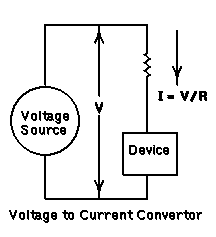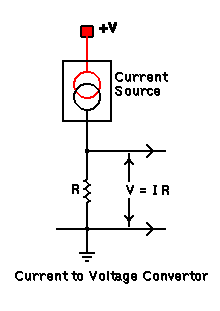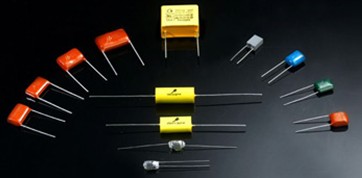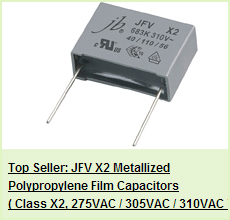2010-12-14 12:12:35
views
Aluminum Electrolytic Capacitors are used in frequency converters, switch-mode power supplies, power converters, uninterruptible power supplies and electronic flash units for studio photography. They are distinguished by high volumetric capacitance and outstanding current-handling capability.
jb Capacitors, founded in 1980 in Taiwan, has long history on producing full series of Plastic Film Capacitors and snap-in, screw, lug Aluminum Electrolytic Capacitors. Compared with other competitors, we offer top quality products with very competitive price. Also, our products are RoHS compliant and SGS certification.
Type: Aluminum Electrolytic Capacitors
Specification:
Load life of 2000 hours at 85℃ and 105℃
Hight ripple current
Smaller size
PCB Mounting
Series:
Snap in type,85℃. for speaker network
Sanp in type,105℃, miniaturized
Snap in type,85℃, general miniaurized, long life
Snap in type,105℃,miniaturized,long life
Screw type,85℃,long life
Screw type,85℃,general, life
Screw type,85℃,miniaturized
Lug type,for photo flash
Lug type, for motor starting
2010-12-13 14:38:15
views
Voltage to Current Convertor
When driving the input (base) of a transistor gain stage:
you must convert the input voltage to a current by using a voltage to current convertor --a resistor.

Current to Voltage Convertor
When deriving a voltage from the collector of a transistor amplifier stage:
you convert the output (collector) current into a voltage by using a Current to Voltage convertor in the collector circuit--you guessed it--a resistor.

2010-12-11 14:35:17
views
Along with the high integration of semiconductor devices, the miniaturization of their components has also advanced. For a dynamic random access memory (DRAM), a high-capacity capacitor with small size is required. Ferroelectric thin film capacitors with extremely large relative permittivity have been developed for this purpose. In film capacitors, the dielectric in such film capacitors comprises a plastic film. The electrodes comprise conductive metal areas. These metal areas are either thin conductor films or conductor layers vapor-deposited onto the plastic film. Thin-film capacitor devices generally comprise a substrate and a lower electrode, a dielectric layer, and an upper layer which are deposited on the substrate in that order. Thin-film capacitors also have a semiconductor substrate functioning as a lower electrode and have a dielectric layer and an upper layer which are deposited on the semiconductor substrate in that order in some cases.
2010-12-10 12:31:0
views
Polarized fixed capacitor 
A polarized ("polar") capacitor is a type of capacitor that have implicit polarity -- it can only be connected one way in a circuit. The positive lead is shown on the schematic (and often on the capacitor) with a little "+" symbol. The negative lead is generally not shown on the schematic, but may be marked on the capacitor with a bar or "-" symbol. Polarized capacitors are generally electrolytics.
Note that you really need to pay attention to correctly hooking a polarized capacitor up (both with respect to polarity, as well as not pushing a capacitor past its rated voltage). If you "push" a polarized capacitor hard enough, it is possible to begin "electrolyzing" the moist electrolyte. Modern electrolytic capacitors usually have a pressure relief vent to prevent catastrophic failure of the aluminum can (but don't bet your eyesight on this).
2010-12-9 1:15:42
views
jb Specialized in producing full series of film capacitors, jb capacitors offer X1 polypropylene film capacitors, AC capacitors.
Temperature range: -55℃~ +105℃
Capacitance Range: 0.0022uF~4.7uF
Rating Voltage: 300V.AC
Application: High Voltage
Type: Polypropylene Film Capacitors

For more details you can visit website www.jbcapacitors.com to search your interesting products.
2010-12-8 1:10:32
views
Aluminum electrolytic capacitors are made by layering the electrolytic paper between the anode and cathode foils, and then coiling the result. The process of preparing an electrode facing the etched anode foil surface is extremely difficult. Therefore, the opposing electrode is created by filling the structure with an electrolyte. Due to this process, the electrolyte essentially functions as the cathode.
Electrolytic capacitors are soaked in a liquid or paper impregnated with a liquid which is not a dielectric but when a voltage is applied creates a layer of aluminium oxide which acts the dielectric. The reaction is dependent on the polarity of the applied voltage. If the polarity is reversed the capacitor will produce a gas and is likely to explode or burst because of the pressure inside and so are not suitable for alternating current applications.
2010-12-7 1:5:59
views
A capacitor is an electronic device for storing charge. Capacitors can be found in almost any complex electronic device. They are second only to resistors in their There are many different types of capacitor but they all work in essentially the same way. A simplified view of a capacitor is a pair of metal plates separated by a gap in which there is an insulating material known as the dielectric. This simplified capacitor is also chosen as the electronic circuit symbol for a capacitor is a pair of parallel plates as shown  .
.
jb Various types of capacitor

2010-12-6 4:20:12
views
Symbol:T
Unit:(s)
When a capacitor discharges its charge throught a resistor, the charge of the capacitor decreases with time. The decreasing charge follows an exponential decay curve.
http://www.jbcapacitors.com/
2010-12-6 1:0:27
views
A super capacitor is also known as a double-layer capacitor. It polarizes an electrolytic solution to store energy electro statically. Though it is an electrochemical device, no chemical reactions are involved in its energy storage mechanism. This mechanism is highly reversible, and allows the ultra capacitor to be charged and discharged hundreds of thousands of times.
A super capacitor can be viewed as two non reactive porous plates, or collectors, suspended within an electrolyte, with a voltage potential applied across the collectors. In an individual super capacitor cell, the applied potential on the positive electrode attracts the negative ions in the electrolyte, while the potential on the negative electrode attracts the positive ions. A dielectric separator between the two electrodes prevents the charge from moving between the two electrodes.
2010-12-3 4:18:42
views
A super capacitor is also known as a double-layer capacitor. It polarizes an electrolytic solution to store energy electro statically. Though it is an electrochemical device, no chemical reactions are involved in its energy storage mechanism. This mechanism is highly reversible, and allows the ultra capacitor to be charged and discharged hundreds of thousands of times.
A super capacitor can be viewed as two non reactive porous plates, or collectors, suspended within an electrolyte, with a voltage potential applied across the collectors. In an individual supercapacitor cell, the applied potential on the positive electrode attracts the negative ions in the electrolyte, while the potential on the negative electrode attracts the positive ions. A dielectric separator between the two electrodes prevents the charge from moving between the two electrodes.





